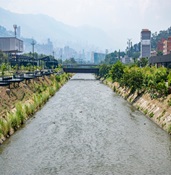Análisis hidrológico de caudales máximos en la cuenca alta del río Medellín (Colombia) con condiciones estacionarias y no estacionarias
Contenido principal del artículo
En la cuenca alta del río Medellín (Colombia) se realizó un estudio hidrológico con el fin de analizar las relaciones lluvia-escorrentía a escala de eventos en esta zona, para la estimación del régimen de caudales máximos asociados a diferentes períodos de retorno en la cuenca del río y subcuencas tributarias, mediante modelación hidrológica que considere la existencia de cambio climático. Este estudio está compuesto por la caracterización de la cuenca de la zona de estudio, así como la caracterización hidrológica, la cual abarca el análisis de datos medidos con alta resolución temporal de precipitación y niveles del río. Se tienen en cuenta también diferentes métodos para la obtención de la información necesaria para la correcta ejecución de actividades de modelación hidrológica semidistribuida, utilizando el software HEC-HMS. El modelo fue calibrado simulando 5 eventos máximos de caudal del año 2021, y luego ejecutado con distintas configuraciones de condición de humedad antecedente, modelos lluvia-escorrentía y la consideración de condiciones estacionarias y no estacionarias (en la precipitación), estas últimas con el fin de evaluar potenciales efectos debido al cambio climático. Según los resultados las diferencias relativas que hay entre los casos estacionarios y no estacionarios (estos últimos siendo usados como proxy para condiciones de cambio climático), en promedio no son tan significativas, habiendo diferencias porcentuales de entre 3-5% entre los casos considerados, obteniendo en este caso magnitudes mayores en los casos no estacionarios.
- Caudales máximos
- modelación semidistribuida hidrológica
- cambio climático
- condición no estacionaria
Pachauri RK, Allen MR, Barros VR et al. Climate change 2014 synthesis report. contribution of working groups I, II, and III to the fifth assessment report of the Intergovernmental Panel on Climate Change. IPCC, Geneva, Switzerland. 2014. Available at: https://research-repository.uwa.edu.au/en/publications/climate-change-2014-synthesis-report-contribution-of-working-grou
Salas JD, Obeysekera J. Revisiting the concepts of return period and risk for nonstationary hydrologic extreme events. Journal of Hydrologic Engineering [Internet]. 2014; 19(3): 554-568. Available at:https://doi.org/10.1061/(ASCE)HE.1943-5584.0 DOI: https://doi.org/10.1061/(ASCE)HE.1943-5584.0000820
Arias PA, Ortega G, Villegas LD, Martínez JA. Colombian climatology in CMIP5/CMIP6 models: Persistent biases and improvements. Revista Facultad de Ingeniería Universidad de Antioquia [Internet]. 2021b; 100: 75-96. Available at: https://www.doi.org/10.17533/udea.redin.20210525 DOI: https://doi.org/10.17533/udea.redin.20210525
Cheng L, and AghaKouchak A. Nonstationary precipitation Intensity-Duration-Frequency Curves for infrastructure design in a changing climate. Scientific Reports [Internet]. 2014; 4(7093): 1-6. Available at. https://doi.org/10.1038/srep07093 DOI: https://doi.org/10.1038/srep07093
Parry ML, Canziani OF, Palutikof JP, Van der Linden PJ, Hanson CE. Climate Change 2007: Impacts, Adaptation and Vulnerability. UK. Cambridge University Press, Cambridge [Internet]. 2007. Available at: https://www.ipcc.ch/site/assets/uploads/2018/03/ar4_wg2_full_report.pdf
World Water Assessment Programme, WWAP. The United Nations World Water Development Report 3: Water in a Changing World. Paris: UNESCO, and London: Earthscan [Internet]. 2009. Available at: https://unesdoc.unesco.org/ark:/48223/pf0000181993
Grajales D, Carvajal-Serna L F. Nonstationary intensity- frequency-duration curves for Medellin River basin. Revista DYNA [Internet]. 2019; 86 (208): 321-328. Available at: DOI:10.15446/dyna.v86n208.69300 DOI: https://doi.org/10.15446/dyna.v86n208.69300
Grajales D. Estimación de curvas intensidad-frecuencia-duración no estacionarias para el Departamento de Antioquia. Medellín. Tesis de maestría, Universidad Nacional de Colombia, Sede Medellín [Internet]. 2019. Available at: https://repositorio.unal.edu.co/handle/unal/78309
Poveda G. La Hidroclimatología De Colombia: Una Síntesis Desde La Escala Inter-Decadal Hasta La Escala Diurna. Revista de la Academia Colombiana [Internet]. 2004; 28(107): 201-222. http://dx.doi.org/10.18257/raccefyn.28(107).2004.1991 DOI: https://doi.org/10.18257/raccefyn.28(107).2004.1991
Rojo JD. Spatial and Temporal Characterization of Colombia´s Hydroclimatology Spatial and Temporal Characterization of Colombia’s Hydroclimatology. Medellin. PhD Thesis Dissertation, Universidad Nacional de Colombia, Sede Medellín [Internet]. 2018. Available at: https://repositorio.unal.edu.co/handle/unal/69017
U.S. Army Corps of Engineers, Hydrologic Engineering Center. HEC-HMS Hydrologic Modeling System, User’s Manual, Version 4.0, CPD-74A. Hydrologic Engineering Center. Davis, CA. 2013. Available at. https://www.hec.usace.army.mil/software/hec-hms/documentation/HEC-HMS_Users_Manual_4.0.pdf
Mapa Digital de Suelos del Departamento de Antioquia, República de Colombia. Escala 1:100.000. Instituto Geográfico Agustín Codazzi, Bogotá. (2014). Available at: https://geoportal.igac.gov.co/contenido/datos-abiertos-agrologia
Rojo JD, Mesa OJ. MJO Influence over northern South American Observations and Modeling, AGU Fall Meeting, Washington DC, 10-14 Dec 2028. http://dx.doi.org/10.13140/RG.2.2.35057.10087
Microzonificación sísmica detallada de los municipios de Barbosa, Girardota, Copacabana, Sabaneta, La Estrella, Caldas y Envigado. AMVA-UNA, Medellín. 2006. Available at: http://repositorio.gestiondelriesgo.gov.co/handle/20.500.11762/19862
Estudios y Diseño de Estabilidad de la Vía Regional Nororiental (Fases 1, 2 y 4) Asociada a la dinámica del Río Medellín y Estudios Básicos de Amenaza de Inundación Asociada al Río Medellín entre la Descarga de la Quebrada La Rodas y El Puente de La Troncal Nordeste en Barbosa. AMVA-UNAL, Medellín, 2018.
Smith R, Vélez MV. Hidrología de Antioquia. 1era. Ed. Secretaría de Obras Públicas, Antioquia-Posgrado en Aprovechamiento de Recursos Hidráulicos; Medellín. 1997.
Plan de Ordenación y Manejo de la Cuenca Hidrográfica del río Aburrá. AMVA-CORNARE-CORANTIOQUIA, Medellín. 2018. Available at: https://cia.corantioquia.gov.co/cgi-bin/koha/opac-detail.pl?biblionumber=16645
Leyenda Nacional de Coberturas de la Tierra. Metodología CORINE Land Cover adaptada para Colombia Escala 1:100.000. Instituto de Hidrología, Meteorología y Estudios Ambientales. Bogotá, D. C., 2010. Available at: https://www.purace-cauca.gov.co/MiMunicipio/DocumentosGestinRiesgoYDesastres/Estudios%20gesti%C3%B3n%20del%20riesgo%20Purac%C3%A9/Leyenda%20nacional%20coberturas%20tierra.pdf
O’Donnell, T. A Direct Three-Parameter Muskingum Procedure Incorporating Lateral Inflow. Hydrological Sciences Journal [Internet]. 1985, 30:4: 479-496. Available at: https://doi.org/10.1080/02626668509491013 DOI: https://doi.org/10.1080/02626668509491013
Bell, FC. The Areal Reduction Factor in Rainfall Frequency Estimation. United Kindom: Institute of Hydrology, No. 35, Wallingford, England, 1976. Available at: https://nora.nerc.ac.uk/id/eprint/5751/1/IH_035.pdf
Chow V, Maidment D, Mays L. Hidrología Aplicada. 1era. ed. Mc Graw Hill; 1994.
UNAL – Universidad Nacional de Colombia. https://medellin.unal.edu.co/noticias/3989-se-debe-respetar-red-de-drenaje-natural-del-rio-medellin-para-evitar-nuevas-emergencias.html
Chica P, Carvajal-Serna LF., Ochoa A. Comparison of stationary and non-stationary estimation of return period for sewer design in Antioquia (Colombia), Anais da Academia Brasileira de Ciencias [Internet]. 2022, 94 (suppl 4):1-14. Available at: https://doi.org/10.1590/0001-3765202220200810 DOI: https://doi.org/10.1590/0001-3765202220200810
Descargas

Esta obra está bajo una licencia internacional Creative Commons Atribución-NoComercial-CompartirIgual 4.0.
Los autores que publican en esta revista están de acuerdo con los siguientes términos:
Los autores ceden los derechos patrimoniales a la revista y a la Universidad del Valle sobre los manuscritos aceptados, pero podrán hacer los reusos que consideren pertinentes por motivos profesionales, educativos, académicos o científicos, de acuerdo con los términos de la licencia que otorga la revista a todos sus artículos.
Los artículos serán publicados bajo la licencia Creative Commons 4.0 BY-NC-SA (de atribución, no comercial, sin obras derivadas).





